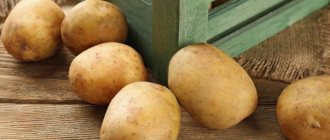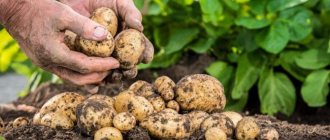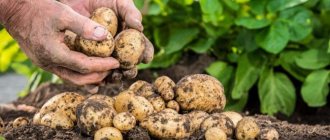It is impossible to imagine Slavic cuisine without potatoes. This product ranks second in terms of consumption of all products. And in first place among vegetables. This is understandable - affordable price, long shelf life, use in a wide variety of dishes - soups, baked goods, side dishes.
Sometimes potatoes sprout, wither, turn green, and rot. This affects the taste and leads to material losses. In 90% of cases, spoilage is caused by incorrect potato storage temperature or lack of suitable conditions. Let's look at this point in detail or how to preserve tubers until the new harvest.
Potato storage conditions
When optimal conditions are created, potatoes retain their taste and external marketable qualities for approximately 8–10 months. In order for the harvested crop to last until the next season without loss, you need to provide it with a comfortable temperature, humidity, ventilation and the required degree of illumination.
Temperature
One of the most important conditions is a constant temperature in the storage. The thermometer readings should be within +2…+5оС. When these indicators are exceeded, the processes of growth and root formation are activated, the tubers begin to germinate and become unsuitable for further storage. At the same time, when the temperature drops below +2°C, a chemical reaction begins in potatoes converting starch into sugar, the tubers become soft and moist, lose their taste and after a short time become completely useless.
Photo gallery: potatoes stored at different temperatures
If the necessary conditions are met, potatoes retain their quality for a long time.
If the room is too warm, the tubers begin to sprout
Once frozen, potatoes are no longer suitable for eating.
Humidity and ventilation
Humidity in storage should be maintained between 75-90%. Exceeding this stimulates the formation of mold fungi; lower values promote the evaporation of moisture from the surface of the tubers. You can control humidity using simple hygrometers or psychrometers.
High humidity in storage provokes the formation of mold and rotting of tubers
Regular ventilation or a ventilation system in the storage allows you to maintain the desired level of humidity and provides the potatoes with the necessary amount of oxygen.
Lighting
When exposed to light, potato tubers produce the toxic glycoalkaloid solanine. It is quite difficult to get poisoned by them: you need to eat a lot of green potatoes along with the peel. However, such tubers lose their taste and presentation; in addition, they become unsuitable for feeding livestock. Therefore, to avoid greening of tuber crops, lighting in the potato storage is not necessary.
When exposed to light, potatoes accumulate poisonous solanine.
Critical temperature for potatoes. What temperature above zero can potatoes withstand?
It is best to plant when the soil temperature is 7-10 ° C, daytime is in the range of 18 ° C, night - 12-18 ° C. The optimal soil condition for root growth is from 10 to 35 ° C, the most active development occurs at 15 -20 ° C. Conditions are similar for the development of stolons.
For tops growth - from 7 to 30 ° C, the best regime is from 20 to 25 ° C. The appearance of tubers is caused by a short photoperiod and includes growth hormones. The cooler the soil temperature, between 15 and 20°C, the faster the tubers will form and in greater numbers.
The process is favored by low levels of nitrogen and high levels of sucrose in the plant. High temperatures (35-40° C) reduce and actually stop the formation of tubers. Also, long day lengths delay the onset of tuber development.
Too high temperatures have a detrimental effect on crop growth
- At 9°C there is a slight elongation of seedlings, very slow at 6°C.
- At temperatures below 6 °C, development practically stops.
- Leaving tubers in soil at 1-2°C for several days causes severe damage that affects normal plant growth.
Potatoes prefer well-drained, fertile soil high in organic matter, with an acidity level of 5.0 to 5.5. As the soil becomes more alkaline, the size of the crop increases, but so does the incidence of scab, a condition that affects the skin but not the nutritional value of the product.
Temperatures from 12 to 18 ° C are considered best for harvesting and processing tubers. Under cold and heat stress, when below 5 ° C and above 25 ° C, they are susceptible to diseases and the risk of microbial rot.
Potato varieties suitable for long-term storage
Even if all storage conditions are met, it is impossible to guarantee the complete safety of the crop without knowing the characteristics of the variety stored for storage. The keeping quality of potatoes does not depend on the color of the tuber and the starch content; the main criterion when choosing a variety for storage is the period of ripening and harvesting.
Early potato varieties cannot be stored for long periods of time. The optimal period is 3–4 months, after which the tubers lose most of their commercial qualities. They are stored only for use as planting material.
Potatoes of medium and mainly late varieties are stored for long-term storage, reaching technical ripeness approximately 100–130 days after planting. It has a thick peel and has a full range of trace elements and tannins. The following varieties have the highest shelf life:
- Lorch. One of the oldest domestic varieties with a medium-late ripening period. The tubers are large, with white skin, and are little affected by late blight and viral diseases.
- Bryansk is reliable. Light beige tubers with white flesh, resistant to pests and viruses.
- Stonefly. Light pink potatoes with small eyes, perfectly stored until spring.
- Atlant. Belarusian mid-late variety with round brownish tubers. Is immune to many viral and bacterial diseases.
- Asterix. Medium late ripening variety. Oval tubers with red skin and yellow flesh. Resistant to transportation and mechanical damage.
- Crane. Round red potatoes of different sizes. During storage they are almost not susceptible to disease.
- Loshitsky. Mid-late variety for universal use. The tubers are elongated oval and creamy white in color.
Photo gallery: potato varieties for long-term storage
Lorch is the oldest variety of domestic selection
Atlas has excellent keeping quality
The crane is perfectly stored in the cellar until spring
Vesnyanka - resistant to various diseases and a short-lived variety
Loshitsa potatoes are immune to late blight and remain until the next season
Some nuances
Every housewife knows that the minimum storage temperature for potatoes should be from +2 to +3. But if the goal is simply to preserve the tubers for 1-2 months, then the degree level can be increased to +12.
In order for potatoes to germinate faster (for planting the latter), it is necessary to provide them with heat (+14 +18) and humidity. In this case, you will get excellent seed material.
At low humidity (less than 60%), the volume of potatoes decreases. To do this, you simply need to transfer the fruits to a more humid place.
When storing in the cellar, you should not regularly move good potatoes from place to place in search of damaged ones. This can inadvertently damage or hit entire tubers, which will subsequently become unusable. It is better to take care immediately when storing the optimal layer of tubers, so that later it will be easy to identify spoiled fruits.
Preparing potatoes for storage
Preparing potatoes for storage is a very important event that affects their safety. Even under ideal conditions, tubers will not last long if they have not been properly prepared.
- First of all, the potatoes must be thoroughly dried. This should be done in a well-ventilated but dimly lit room. When drying in the open air, you should scatter the potatoes in the shade, excluding direct sunlight. The duration of the procedure depends on the ambient humidity and the general condition of the tubers. The degree of dryness is assessed visually; the presence of moisture spots on the surface of tubers is unacceptable.
You can spread the tubers for drying in no more than 2–3 layers
- The next stage is culling diseased, damaged potatoes and sorting them by size. Tubers with signs of disease, cut, crushed during harvesting must be separated from the main mass, because one diseased fruit can become a source of infection for several others. It is necessary to divide tubers into large, medium and small because the intensity of respiratory processes depends on the area of the peel, and this, in turn, affects the shelf life.
- When sorting through dried potatoes, you need to wipe off any stuck lumps of soil, if any, without causing damage. The remaining soil may contain fungi and viruses that cause various diseases.
- Some potato growers advise treating sorted potatoes with antifungal biological products to avoid infection during storage. It is best to use Fitosporin for this purpose. After processing, dry it again and only then store it.
Video: harvesting and preparing potatoes for storage
Storing potatoes in the winter at the dacha
For city residents, a dacha is both a place of relaxation and an area where they can grow organic vegetables and fruits. Having harvested potatoes, summer residents decide where and how best to preserve them. You usually choose from two options:
- transport everything to the city at once and store it in the apartment (in the absence of any other premises);
- leave it at the dacha and take vegetables from there as needed.
Many consider the second to be more preferable, so they equip cellars in areas.
Cellar storage
To store vegetables, including potatoes, a cellar or basement needs to be prepared.
- First, you need to check and clean the ventilation vents in the room. If they are not there, then it is advisable to organize ventilation. This is necessary to allow fresh air to penetrate and remove moisture from the storage area.
“Pipes” made of metal mesh provide air access to the lower layers of potatoes
- Next, you should check the thermal insulation. If necessary, the ceiling and walls can be additionally covered with materials that will prevent the penetration of cold and heat, ensuring a constant temperature within the required limits.
- An important stage in preparing the room is treating the walls, ceiling, shelving, and shelves with disinfectants. The simplest means are solutions of lime (you can add copper sulfate) and potassium permanganate, but you can also use special mixtures for disinfecting premises. In addition, fumigation with sulfur or red pepper is carried out to repel rodents.
- After all procedures, the storage must be dried.
Wooden racks are the best solution for storing potatoes
When the storage is prepared, the tubers are sorted and sorted, you can proceed to the bookmark. In the cellar, potatoes are stored on racks, in bags, boxes or containers. You can pile the root vegetables on the floor, but for this the size of the vegetable storage must be quite large.
Potatoes can be stored in piles
It is convenient to store potatoes in bags. They are made of breathable material, so that the tubers in them will be normally provided with oxygen. The weight can be varied at your own discretion by adjusting the load of the bag. They can be placed in any free place. In addition, to take potatoes home, there is no need to reload them into bags or bags.
Burlap allows air to pass through well
Storing potatoes in boxes and containers also has its advantages. They can be installed one on top of the other, which saves a lot of space. They have many slits and slits, and this ensures good ventilation of the tubers. There is another undoubted advantage in using wooden containers: wood emits formaldehyde, which inhibits the appearance and spread of mold on vegetables.
Boxes can be stacked one on top of the other, saving space
We should not forget that when using any container, potatoes need to be sorted approximately once every month and a half.
Storage in a pit or trench
If you don’t yet have a cellar at your dacha, you can perfectly preserve your potato harvest in another way.
- Dig a hole or trench on an elevated area (to avoid flooding by rain and melt water). The dimensions do not have strict parameters and depend on the level of groundwater, the depth of soil freezing and the amount of potatoes planted.
- The bottom of the trench should be insulated: lay boards, sprinkle a small layer of straw or sawdust on top, throw on rags or rag scraps.
- On the sides you need to strengthen any material that can separate the potatoes from the damp soil: sheets of foam, plywood, plastic film.
- To ventilate the storage, pipes with a diameter of 1-2 inches with drilled holes should be installed at opposite ends. The pipes should differ in length by about 0.5 m, the short one should be at least 1 m above the soil level. To prevent water from getting into them during precipitation, you need to equip them with a canopy.
- When laying potatoes, it is advisable to add a 10–15 cm layer of straw every 3–4 layers of vegetables.
- Having placed the entire prepared amount of potatoes in the trench, straw is laid on top to the soil level and covered with boards.
- A 20-30 cm layer of earth is poured onto the boards, covered with some kind of insulator (roofing felt, roofing felt, old linoleum, etc.) and the earth is poured again.
- To make it easier to remove potatoes from the hole, you can cover one edge of the boards with rags instead of covering them with earth.
How and where to store potatoes in the apartment so that they do not sprout
Most private sector houses have special basements and storage rooms on the ground floors. There are buildings in the courtyards. It is more difficult to organize long-term maintenance of potatoes in a city apartment.
The main enemy is high temperature. Sticking to parameters +2-4 is difficult. On balconies and loggias, potatoes sprout and freeze. Without glazing, moisture gets in and rot appears.
Without a cellar
In apartment conditions, special boxes are installed on balconies and loggias, the bottom and sides are insulated with polystyrene foam, and the top is covered with blankets. With proper preparation, the vegetable will not freeze at -20-30 degrees, will not turn green, and will not germinate.
In private houses without a basement, storage is carried out in sheds, garages, and dressing rooms. The container or room requires insulation; the method described above with polystyrene foam will do. It is important to check regularly.
To monitor temperature indicators, we recommend placing a thermometer in the box with potatoes.
No balcony in winter
Storage is carried out in the refrigerator. The downside of this option is limited space. You won’t be able to place more than a bucket of potatoes. The second option is niches under the windows. They are in old-style apartments.
Short-term storage is possible at room temperature. The vegetables are transferred to a bucket, covered, and put in a dark place. Suitable pantries and kitchen cabinets. It is good to place it under the sink, where the air humidity is much higher. But water should not get in.
Storing potatoes at home
If you decide to store potatoes at home, then a loggia or pantry is suitable for this. The simplest potato storage facility can be built independently.
- Take two boxes of different sizes.
- Place the smaller box in the larger one.
- Fill the space between them with a heat insulator (mineral wool, polystyrene foam, etc.).
- Insert a ventilation tube at the bottom of the box.
- Cover the top of the resulting container with a lid made of heat-proof material.
- The inner box can be replaced with a woven bag.
This design is considered the simplest. Some craftsmen are improving such storage facilities by adding heating and ventilation systems, but this requires certain skills and abilities.
Video: cabinet for storing vegetables on the balcony
Diseases to which potatoes are exposed during storage
If the rules for preparation and storage are not followed, potato tubers can be affected by various diseases. These can be fungal, bacterial and non-infectious diseases.
Fungal diseases
The causative agents of these diseases in the vast majority of cases are found on the skin of the tuber when it is stored. To remove them, you just need to wash the potatoes with water, but this, unfortunately, significantly reduces the shelf life. The most common of them are:
- Late blight. Hard spots of brown or gray color appear on the tubers, which over time grow inward and to the sides, turning into dry or wet rot. The disease develops rapidly at elevated temperatures during the initial periods of storage. The causative agent of late blight gets onto the potato during harvesting in contact with the affected tops. The disease is not transmitted to the storage facility.
- Fusarium. Dull, grayish-brown spots appear on the tuber, the pulp inside dries out, and voids filled with fungal spores form. Tubers with damage and adhering pieces of soil are most susceptible to disease. The spores infect all nearby tubers with the Fusarium fungus.
- Rhizoctoniosis (black scab). It is characterized by the appearance of flat fungal sclerotia, similar to dried soil. Infection occurs during the growth period and does not spread to the storage facility.











